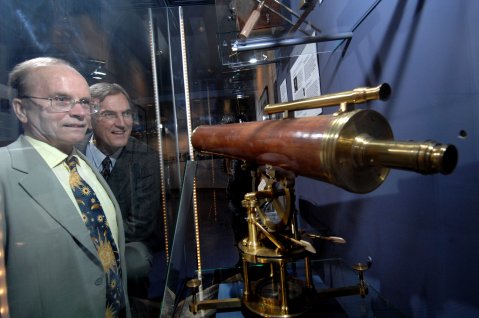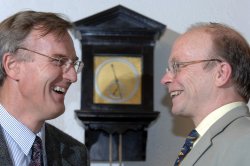At the heart of science and religion

A major new four-year long series of lectures looking at the debate between science and religion is to launch at the University of St Andrews.
Described as a ‘vision for a better world’, the ambitious series of twelve lectures will bring some of the world’s top experts to St Andrews to explore the natural tensions between the two subjects.
The lecture series, to be launched later this month, was developed by St Andrews’ academics, Professors Eric Priest and Alan Torrance following the former’s involvement with the Faraday Institute for Science and Religion at the University of Cambridge.
 The unusual partnership between a Professor of Theoretical Solar Physics (Professor Priest) and a Professor of Systematic Theology (Professor Torrance) is the first such collaboration between the Schools of Divinity and Mathematics & Statistics and represents a major new initiative at the University.
The unusual partnership between a Professor of Theoretical Solar Physics (Professor Priest) and a Professor of Systematic Theology (Professor Torrance) is the first such collaboration between the Schools of Divinity and Mathematics & Statistics and represents a major new initiative at the University.
The aim of the series is to break down barriers and encourage constructive dialogue and an exchange of ideas on the many points of contact between science and religion.
Professor Priest explained, “At this time of a rise of unhealthy and dangerous fundamentalism across our culture, there is an urgent need to become better informed about the nature of the scientific enterprise and also of religious thought. Different groups need to understand each other better and to agree to live at peace in a tolerant and civilised world. Here both science and religion have key insights about our human nature, our creativity and our possible future.”
The series is supported by funding from the John Templeton Foundation and is named after James Gregory, one of the University’s most famous sons who invented the Gregorian telescope and was one of the founders of calculus.
Lecture topics will include subjects such as the origin of life, human creativity, biological evolution, global warming and the future of the planet, genetics and medical ethics, psychology and religion, biotechnology, cosmology and the origin of the universe. The first lecture, by the Bishop of Durham, N.T. Wright, will pose the question `can a scientist believe in the resurrection?’ while another will debate the role of science in Islam.
Professor Torrance added, “It is clear that there are many natural tensions at the interface between science and religion, which we aim to explore in an open and honest way with the help of some eminent thinkers. At the same time we’d really like anyone who is interested to feel they can come along to these lectures and contribute to the discussion. We live in a world where science is extremely important, but many questions that are of great importance to us as human beings cannot be answered by science.”
The first lecture in the James Gregory public lectures on science and religion, `Can a Scientist believe in the Resurrection?’, will be delivered by the Bishop of Durham, N.T. Wright at the University of St Andrews on 20 December 2007.
For further information, visit www.jamesgregory.org
ENDS
NOTE TO EDITORS:
THE RESEARCHERS ARE AVAILABLE FOR INTERVIEW:
Professor Eric Priest, 01334 463 709, [email protected]
Professor Alan Torrance, 01334 462 843, [email protected]
NOTE TO PICTURE EDITORS:
IMAGES ARE AVAILABLE FROM THE PRESS OFFICE – CONTACTS BELOW. PLEASE CREDIT ALAN RICHARDSON, PIX-AR.
Issued by the Press Office, University of St Andrews
Contact Gayle Cook, Press Officer on 01334 467227 / 462529, mobile 07900 050 103, or email [email protected]
Ref: Science and religion 051207
View the latest University press releases at www.st-andrews.ac.uk
Category University news